The Occlusion Balloon Catheter Market is estimated to be valued at USD 1.3 billion in 2025 and is projected to reach USD 3.1 billion by 2035, registering a compound annual growth rate (CAGR) of 8.9% over the forecast period.
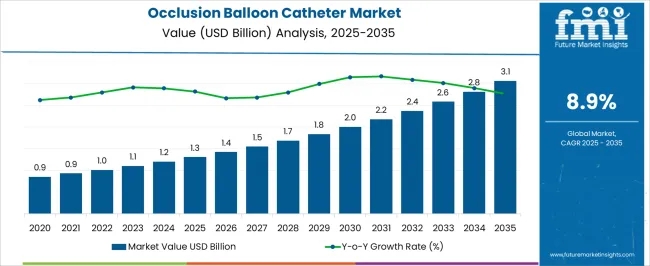
| Metric | Value |
|---|---|
| Occlusion Balloon Catheter Market Estimated Value in (2025 E) | USD 1.3 billion |
| Occlusion Balloon Catheter Market Forecast Value in (2035 F) | USD 3.1 billion |
| Forecast CAGR (2025 to 2035) | 8.9% |
The Occlusion Balloon Catheter market is witnessing strong growth, driven by the rising prevalence of cardiovascular diseases, particularly coronary artery disease, and the increasing demand for minimally invasive interventions. Adoption is being supported by advancements in catheter design, materials, and delivery systems that enhance procedural efficiency and patient safety. The development of balloon catheters with superior flexibility, trackability, and durability allows for precise occlusion and reduced risk of vascular injury.
Hospitals and specialized cardiac care centers are increasingly adopting these devices due to their effectiveness in interventional cardiology procedures, including angioplasty and vessel occlusion during complex surgeries. Technological innovations such as high-pressure inflation, radiopaque markers, and optimized balloon compliance are improving procedural outcomes and reducing complications.
Growing awareness of less invasive cardiovascular treatment options, coupled with rising investments in cardiac healthcare infrastructure, is further supporting market expansion As healthcare providers seek solutions that improve patient recovery, reduce hospitalization time, and ensure safety during procedures, the occlusion balloon catheter market is expected to sustain robust growth in the coming decade.
The occlusion balloon catheter market is segmented by material type, indication, end user, and geographic regions. By material type, occlusion balloon catheter market is divided into Latex, Silicone, and Others. In terms of indication, occlusion balloon catheter market is classified into Coronary Artery Diseases and Peripheral Vascular Diseases. Based on end user, occlusion balloon catheter market is segmented into Hospitals, Ambulatory Surgical Centers, and Cardiac Catheterization Laboratories. Regionally, the occlusion balloon catheter industry is classified into North America, Latin America, Western Europe, Eastern Europe, Balkan & Baltic Countries, Russia & Belarus, Central Asia, East Asia, South Asia & Pacific, and the Middle East & Africa.
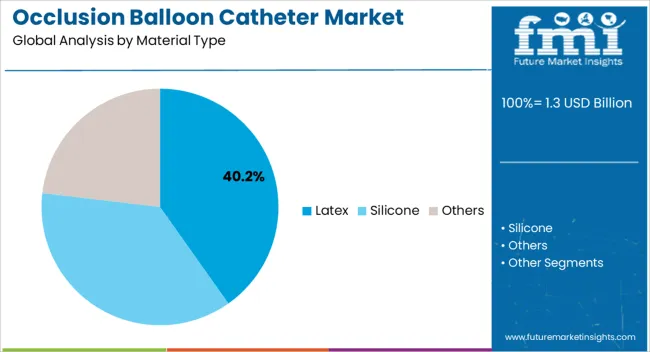
The latex segment is projected to hold 40.2% of the market revenue in 2025, making it the leading material type. Growth in this segment is driven by the inherent elasticity, durability, and biocompatibility of latex, which enables reliable balloon inflation and vessel occlusion during interventional procedures. Latex catheters provide excellent conformability to vascular structures, ensuring precise occlusion and reducing the risk of procedural complications.
Manufacturing advancements have improved latex quality, reducing allergenic potential while maintaining mechanical strength and flexibility. These properties make latex-based catheters particularly suitable for diverse clinical applications, including coronary interventions and peripheral vessel occlusions.
Hospitals and cardiac care centers favor latex catheters for their proven performance, cost-effectiveness, and procedural reliability As procedural volumes increase and minimally invasive cardiovascular interventions become more prevalent, latex catheters are expected to maintain their leading position, supported by technological improvements and strong clinical adoption globally.
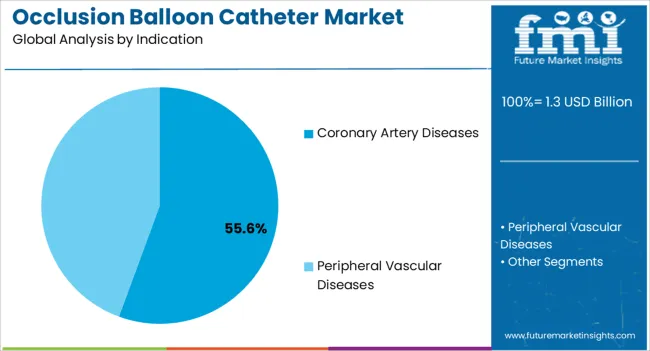
The coronary artery diseases segment is expected to account for 55.6% of the market revenue in 2025, establishing it as the leading indication area. Its growth is being driven by the rising prevalence of cardiovascular conditions, including atherosclerosis, heart attacks, and other coronary disorders, which create strong demand for minimally invasive treatment solutions. Occlusion balloon catheters are widely employed in angioplasty and vessel occlusion procedures, offering precise control, safety, and improved clinical outcomes.
Technological advancements in balloon compliance, inflation pressure control, and radiopacity are enhancing procedural success in coronary interventions. Hospitals and interventional cardiologists increasingly prefer these devices due to their reliability and effectiveness in reducing intraoperative complications.
Government initiatives, awareness programs, and early detection efforts for coronary artery diseases are also supporting the adoption of occlusion balloon catheters With rising cardiovascular patient populations and an increasing preference for minimally invasive treatments, the coronary artery diseases segment is expected to remain the primary driver of market growth.
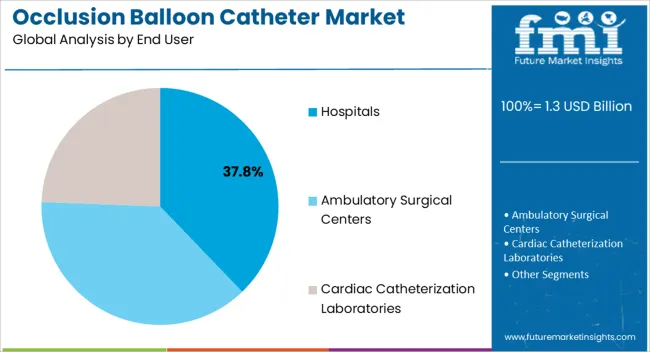
The hospitals segment is projected to hold 37.8% of the market revenue in 2025, making it the leading end-use industry. Growth in this segment is being driven by the concentration of interventional cardiology procedures in hospital settings, where advanced equipment, trained staff, and emergency support are available.
Hospitals are increasingly adopting occlusion balloon catheters due to their critical role in procedures such as angioplasty, vessel occlusion during surgeries, and coronary interventions. The ability to deliver precise occlusion, reduce procedural risk, and improve patient recovery time strengthens their adoption in hospital settings.
Technological innovations, including improved catheter flexibility, radiopaque markers, and high-pressure inflation, enhance procedural efficiency and outcomes, further reinforcing hospitals as the primary end user Increasing investment in cardiac healthcare infrastructure, the expansion of specialized cardiac centers, and a rising number of elective and emergency procedures are expected to sustain hospitals as the largest end-use segment in the occlusion balloon catheter market.
Balloon Catheter is an advance medical device which consists of guidewires and catheter. This balloon catheter is inserted into the femoral artery of the leg or sometimes in radial artery of the arm to treat the constricted in the blood vessels. Blood vessel constriction are caused due to arteriosclerosis i.e. deposition of lipid substances in blood vessels.
Balloon catheters are of two types, high-pressure balloon catheter and low-pressure balloon catheter. A low-pressure balloon catheter is also referred as occlusion balloon catheter or elastomeric balloon catheter. Occlusion balloon catheter is typically deep molded in a tubular shape and then expanded to several times their original size during use.
Occlusion balloon catheter have the thin wall surrounding its balloon and having high tensile strength. Occlusion balloon catheter is used for sealing when precise size and shape are required.
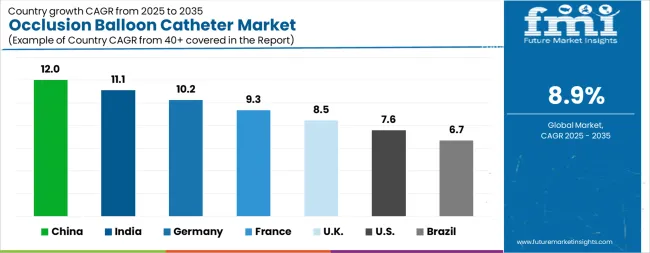
| Country | CAGR |
|---|---|
| China | 12.0% |
| India | 11.1% |
| Germany | 10.2% |
| France | 9.3% |
| UK | 8.5% |
| USA | 7.6% |
| Brazil | 6.7% |
The Occlusion Balloon Catheter Market is expected to register a CAGR of 8.9% during the forecast period, exhibiting varied country level momentum. China leads with the highest CAGR of 12.0%, followed by India at 11.1%. Developed markets such as Germany, France, and the UK continue to expand steadily, while the USA is likely to grow at consistent rates. Brazil posts the lowest CAGR at 6.7%, yet still underscores a broadly positive trajectory for the global Occlusion Balloon Catheter Market. In 2024, Germany held a dominant revenue in the Western Europe market and is expected to grow with a CAGR of 10.2%. The USA Occlusion Balloon Catheter Market is estimated to be valued at USD 465.1 million in 2025 and is anticipated to reach a valuation of USD 964.4 million by 2035. Sales are projected to rise at a CAGR of 7.6% over the forecast period between 2025 and 2035. While Japan and South Korea markets are estimated to be valued at USD 63.9 million and USD 44.3 million respectively in 2025.
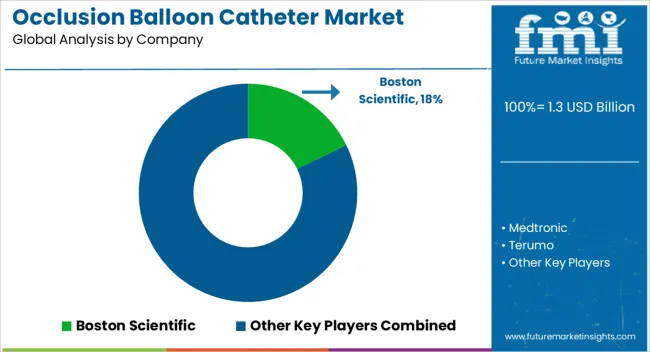
| Item | Value |
|---|---|
| Quantitative Units | USD 1.3 Billion |
| Material Type | Latex, Silicone, and Others |
| Indication | Coronary Artery Diseases and Peripheral Vascular Diseases |
| End User | Hospitals, Ambulatory Surgical Centers, and Cardiac Catheterization Laboratories |
| Regions Covered | North America, Europe, Asia-Pacific, Latin America, Middle East & Africa |
| Country Covered | United States, Canada, Germany, France, United Kingdom, China, Japan, India, Brazil, South Africa |
| Key Companies Profiled | Boston Scientific, Medtronic, Terumo, Cook Medical, Stryker, Merit Medical Systems, Front Line Medical Technologies, and Oscor |
The global occlusion balloon catheter market is estimated to be valued at USD 1.3 billion in 2025.
The market size for the occlusion balloon catheter market is projected to reach USD 3.1 billion by 2035.
The occlusion balloon catheter market is expected to grow at a 8.9% CAGR between 2025 and 2035.
The key product types in occlusion balloon catheter market are latex, silicone and others.
In terms of indication, coronary artery diseases segment to command 55.6% share in the occlusion balloon catheter market in 2025.






Our Research Products

The "Full Research Suite" delivers actionable market intel, deep dives on markets or technologies, so clients act faster, cut risk, and unlock growth.

The Leaderboard benchmarks and ranks top vendors, classifying them as Established Leaders, Leading Challengers, or Disruptors & Challengers.

Locates where complements amplify value and substitutes erode it, forecasting net impact by horizon

We deliver granular, decision-grade intel: market sizing, 5-year forecasts, pricing, adoption, usage, revenue, and operational KPIs—plus competitor tracking, regulation, and value chains—across 60 countries broadly.

Spot the shifts before they hit your P&L. We track inflection points, adoption curves, pricing moves, and ecosystem plays to show where demand is heading, why it is changing, and what to do next across high-growth markets and disruptive tech

Real-time reads of user behavior. We track shifting priorities, perceptions of today’s and next-gen services, and provider experience, then pace how fast tech moves from trial to adoption, blending buyer, consumer, and channel inputs with social signals (#WhySwitch, #UX).

Partner with our analyst team to build a custom report designed around your business priorities. From analysing market trends to assessing competitors or crafting bespoke datasets, we tailor insights to your needs.
Supplier Intelligence
Discovery & Profiling
Capacity & Footprint
Performance & Risk
Compliance & Governance
Commercial Readiness
Who Supplies Whom
Scorecards & Shortlists
Playbooks & Docs
Category Intelligence
Definition & Scope
Demand & Use Cases
Cost Drivers
Market Structure
Supply Chain Map
Trade & Policy
Operating Norms
Deliverables
Buyer Intelligence
Account Basics
Spend & Scope
Procurement Model
Vendor Requirements
Terms & Policies
Entry Strategy
Pain Points & Triggers
Outputs
Pricing Analysis
Benchmarks
Trends
Should-Cost
Indexation
Landed Cost
Commercial Terms
Deliverables
Brand Analysis
Positioning & Value Prop
Share & Presence
Customer Evidence
Go-to-Market
Digital & Reputation
Compliance & Trust
KPIs & Gaps
Outputs
Full Research Suite comprises of:
Market outlook & trends analysis
Interviews & case studies
Strategic recommendations
Vendor profiles & capabilities analysis
5-year forecasts
8 regions and 60+ country-level data splits
Market segment data splits
12 months of continuous data updates
DELIVERED AS:
PDF EXCEL ONLINE
Retinal Vein Occlusion Treatment Market - Outlook 2025 to 2035
Chronic Venous Occlusions Treatment Market Size and Share Forecast Outlook 2025 to 2035
Balloon Catheters for Bile Stone Removal Market Size and Share Forecast Outlook 2025 to 2035
Balloon Catheters Analysis by Product Type by Indication and by End User through 2035
Cryoballoon Ablation System Market – Trends & Forecast 2025 to 2035
The Dual Balloon Angioplasty Catheter Market is segmented by Peripheral, and Coronal from 2025 to 2035
Micro Balloon Catheter Market Growth – Trends & Forecast 2025 to 2035
Cutting Balloons Market Insights – Growth, Demand & Forecast 2025 to 2035
Serration Balloon Catheters Market
Stent Graft Balloon Catheter Market Insights - Growth & Forecast 2025 to 2035
Intra-Aortic Balloon Pump (IABP) Market Size and Share Forecast Outlook 2025 to 2035
Intra-gastric Balloons Market Size and Share Forecast Outlook 2025 to 2035
Radiofrequency Balloon Catheter Market Size and Share Forecast Outlook 2025 to 2035
Pulmonary Dilation Balloon Market
Kidney Stone Extraction Balloon Market Size and Share Forecast Outlook 2025 to 2035
Middle East and Africa Latex Foil Balloons Market Size and Share Forecast Outlook 2025 to 2035
Catheter Market Insights by Product, Indication, End-user, and Region 2025 to 2035
Catheter-Directed Thrombolysis Market Growth - Trends & Forecast 2025 to 2035
Catheter Tip Syringe Market Size, Share & Demand Outlook 2025 to 2035
Catheter Associated Urinary Tract Infections (UTI) Treatment Market - Demand & Forecast 2025 to 2035

Thank you!
You will receive an email from our Business Development Manager. Please be sure to check your SPAM/JUNK folder too.
Chat With
MaRIA